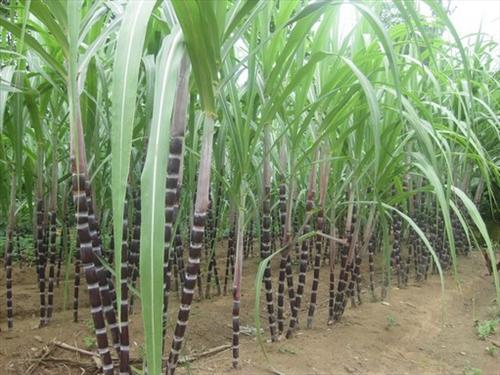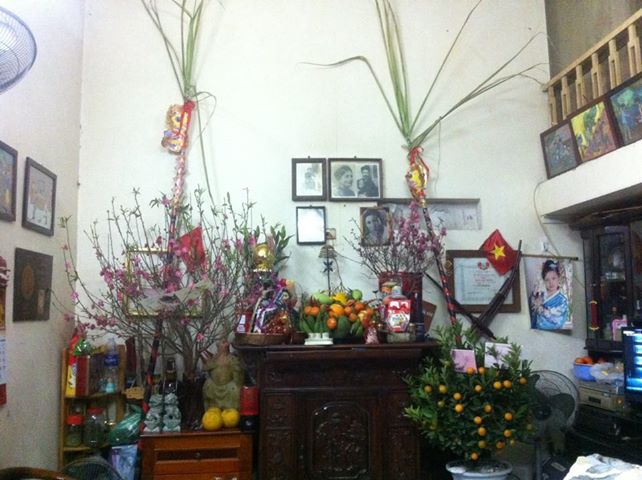
There are many explanations for this strange custom, such as people keeping the sweetness from the old year to the new year in the hope that everything in the year will be smooth and sweet; some people explain that each segment of sugarcane is like a ladder for the soul to climb to heaven to the realm of the supernatural; some places explain that there are two sticks for grandparents to lean on to find their way back to their children and grandchildren, etc. Every explanation shows the mind turning towards the source and towards goodness.
Those who follow and read Buddhism have other interpretations that need to be consulted. In general, funerals, offerings, and rituals of the Kinh people are a complex phenomenon, integrating many beliefs. The beliefs of ancient Vietnam (before the common era) were never recorded by the Vietnamese at that time, so it is difficult for us to find specific ones to compare. The image of sugarcane is not very clear, the image of reeds is only an estimate. The tool for pressing molasses to make sugar has not been excavated. For the Kinh people, in the integration, we can most easily recognize the strong Buddhist nature in this act of worship. Burning five-part incense, displaying a tray of five fruits, chanting Amitabha... are all Buddhist, not only influencing the Kinh people but also influencing the Chinese people since the time of Chinese domination, which means a very long time ago.
Indian Buddhism, according to the previous tradition, considered the ancestors of Sakya to be of the Sugarcane family, in Sanskrit Gautama, transliterated and written in Chinese as Cu Dam or also read as Co Dam. Regarding the origin of the Buddha's Sugarcane family, there are many theories recorded early in different scriptures, with great similarities and small differences. According to the book "Twelve Journeys", in a distant past life, there was a Bodhisattva who was a king. His parents died early, so he gave the throne to his younger brother and studied with a Brahmin, living in a sugarcane garden. People called the Bodhisattva's teacher "Dai Cu Dam", and called Bodhisattva "Tieu Cu Dam". At that time, there were 500 robbers who robbed a government official's house. On the way to escape, they ran through a sugarcane garden, dropping the stolen items in the garden. The pursuers followed and found the place. Seeing this, they thought the Bodhisattva was a robber, then shot him with an arrow, blood flowing all over the ground. The Great Gautama used his divine eye to see everything, and with pity and tears, he scooped up the blood that was still on the ground, mixed it with mud, and put it in two small bowls. He placed them on either side of the garden and prayed: If Gautama is sincere, the angels will turn the blood into a human being. Ten months later, the left bowl turned into a son, the right bowl turned into a daughter, and from then on, he took the surname Gautama.

Sugarcane on the altar on Tet holiday
The book “Great Sun Sutra Commentary” volume 16 records that the immortal Gautama (Gùtâm Tiên) committed adultery in the sky, a drop of dirty water fell to the ground, grew into two sugarcane plants, then thanks to the photosynthesis of the sun, gave birth to two sons, one of whom became king of the Shakya clan. Therefore, it is said that the immortal Gautama was the ancestor of Shakya, and the Shakya clan was also called the Cam gia race, meaning Sugarcane race.
Another legend about sugarcane is also recorded in the Buddhist canon about King Cam Gia, or King of Sugarcane. The Sutra “Buddha’s Original Practices” volume 5 records that before King Cam Gia, there was a king named Dai Mao Thao Vuong, who abandoned the throne to become a monk and obtained five supernatural powers, and was called Vuong Tien. Vuong Tien was old and weak and could not walk. His disciples went out to beg for food. Fearing that his teacher at home would be captured by tigers and wolves, he put him in a cage made of grass and hung him on a tree. At that time, a hunter mistook Vuong Tien for a white bird and shot him dead. Where Vuong Tien’s blood dripped, two sugarcane plants later grew. The sun was so hot that the two sugarcane plants split open and gave birth to a boy and a girl. The high-ranking mandarin heard the news and took them to the palace to raise them. The boy was born because the sunlight split the sugarcane plant, so he was named Thien Gia Sinh; and because the sun burned him, he was called Nhat Chung; and the girl was named Thien Hien. Later, Thien Sinh was made king and Thien Hien was made queen. Thien Hien gave birth to a son. Later, the king took two more wives and had four children. Thien Hien wanted to make his son king, so he advised the king to expel the other four sons from the country. Those four sons built a country behind Tuyet mountain and established the Thich Ca family.
In Vietnam, when visiting a temple, that is, coming to the Buddha's place, one must climb a steep slope, people often sell sugarcane as a stick with the meaning of dedicating to the Buddha's land. So, according to tradition, worship is a ritual containing a strong inspiration of going back to the source, the sugarcane here will symbolize the origin of the Buddha's family, worshiping sugarcane is also worshiping the origin of Buddhism.
In real life, many origins of behavior will gradually be forgotten, only customs are preserved as a cultural inertia. Then, the folk, in turn, create many legends and anecdotes to explain, creating a rich and interesting community consciousness. This exists as a creative style of folk language art. However, the inspiration towards the origin is still especially strong when Tet comes, people reflect on the past, practice in the present and hope for the future.
Sugarcane, which brings sweetness to life, is now worshiped, making it more sacred and meaningful.
Author:Nguyen Hung Vi
Newer news
Older news